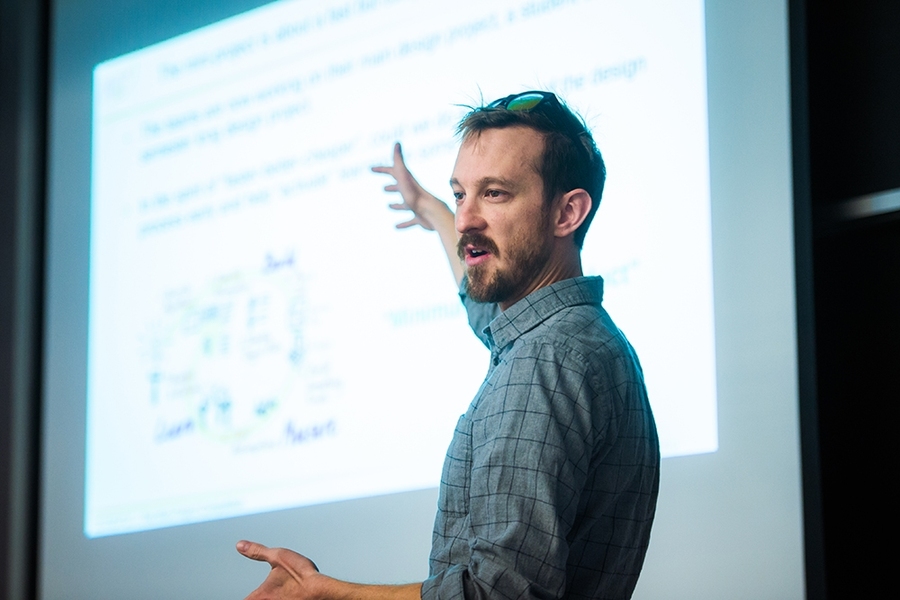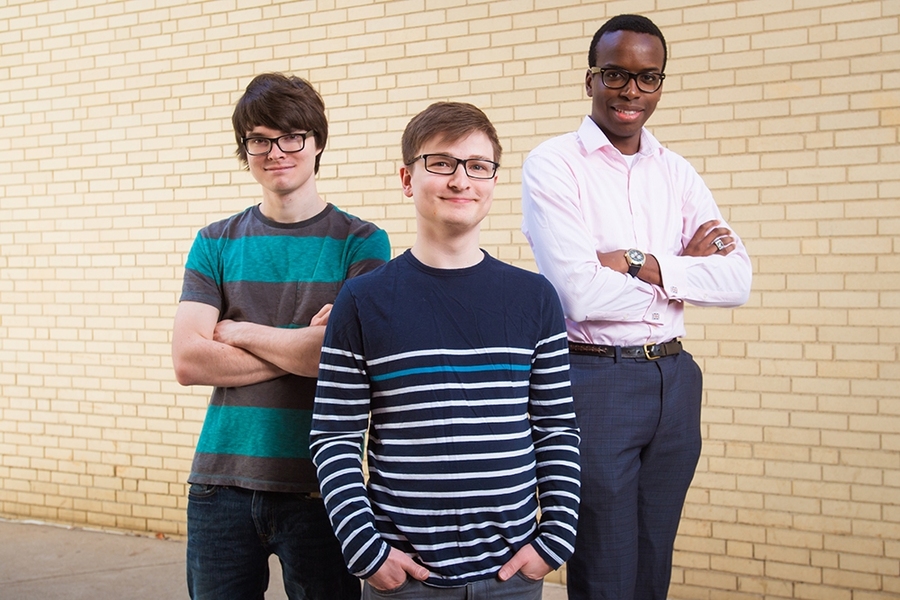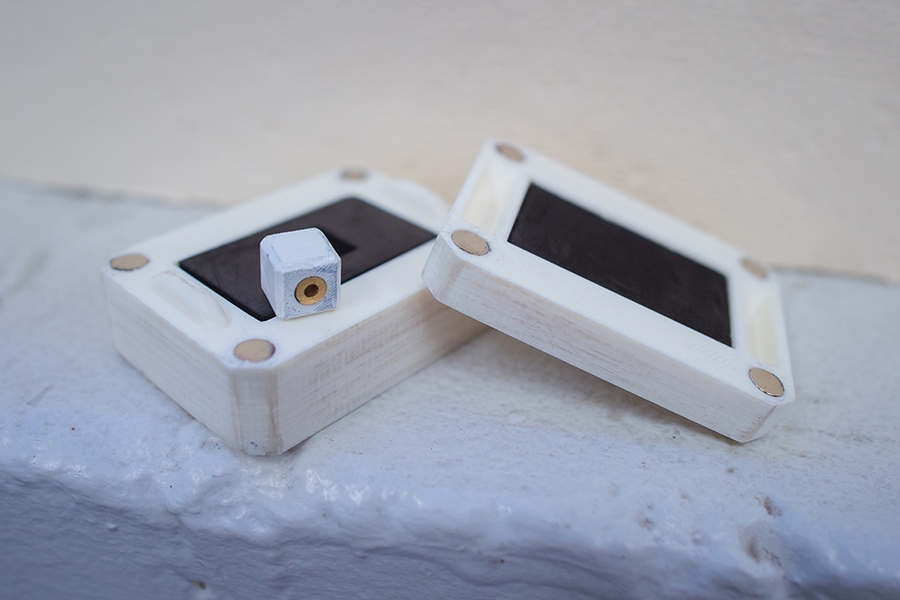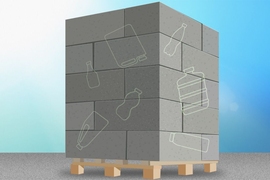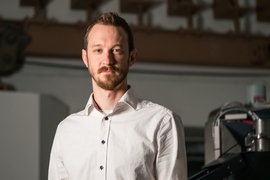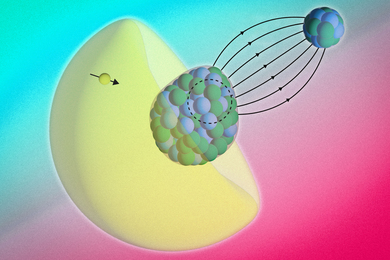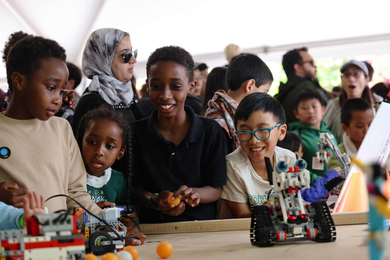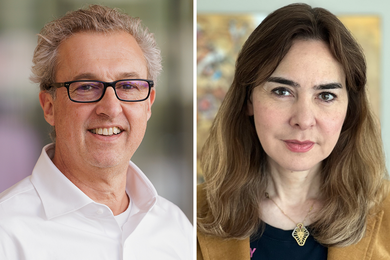On a cool fall morning, approximately a dozen students prepare for presentations in a Building 24 classroom. The students are arranged into four groups, each with a prototype of a small box. Although the boxes are different in shape, color, size, and overall design, all have been designed with one common goal in mind: to improve on the standard packaging for small radioactive sources. Ubiquitous in experimental physics and in nuclear science and engineering, these sealed, radioactive “check sources” are used in everything from undergraduate teaching labs to cutting-edge physics experiments.
Students are presenting these prototypes for a mini design project competition in 22.033 (Nuclear Systems Design). Last year, Michael Short, assistant professor in the Department of Nuclear Science and Engineering (NSE), reshaped and taught this class — focusing on providing hands-on experiences with current design thinking and engineering approaches, as well as building communications skills. Building on this new model, this year the class is taught by Zach Hartwig, assistant professor in NSE and the inaugural holder of the John C. Hardwick Career Development Chair, awarded to young faculty in NSE for three years to foster the development of long-term sustainable energy.
Hartwig, who also holds a co-appointment at MIT’s Plasma Science and Fusion Center, is particularly interested in driving innovations and advancements in nuclear science and engineering by applying design concepts and practices to tackle current challenges in the field. The Nuclear Systems Design class embodies this approach, engaging students in the skills and experiences that will help them to craft effective and scalable solutions.
“We bring together design thinking and the engineering of big, complex systems,” says Hartwig. “This type of thinking is currently applied by some of the most successful companies, from SpaceX and Tesla Motors to Intel and General Electric. Incorporating these new, proven models of innovation into nuclear science and engineering will be essential to enabling our field to positively impact the world.”
Rather than having students work on one major project throughout the entire class, students start with smaller activities, then the mini project, and then — with all of the learning and practice they’ve gained — proceed to the major project.
“The class itself is intentionally structured to mimic the iterative design process,” says Hartwig.
In the first month of the class, students practice design ideation, brainstorming, mind-mapping, empathetic user engagement, and prototyping. The middle two weeks of class focus on communications — with students learning the basics of giving an effective presentation, as well as writing for technical and general audiences. In the final 10 weeks, students work on the major design project, in which they find a real problem related to nuclear science and engineering. Through three prototyping cycles, they work with instructors and users to incorporate feedback into their designs and iterate towards a successful final product.
Students work on the major project in the same teams as for the mini project. Before working on the redesign of the source packaging, the whole class collaborated to identify approximately 20 different problems with the current packaging. They noted that the acrylic case doesn’t provide much shielding from the sample it contains, the case’s fragile hinges can easily break, and the label with information about the source is hard to read. They also considered the fact that actual source is coin-shaped and, if dropped, could easily roll away.
The teams all developed creative solutions directly addressing these problems. Solutions included color-coding the packaging to indicate source types (rather than relying on a hard-to-read label); changing the material to provide better shielding and safety for users; and eliminating the fragile hinge on the lid (substituting with lids that twist or slide open). They also considered the problematic, round shape of the source itself and proposed solutions such as a square-shaped source or a source that stays mounted within the packaging. As they created and iterated on prototypes, students learned to use CAD software, 3-D printers, laser cutters, and other engineering tools.
The panel of judges for the mini-project presentations included Areg Danagoulian, assistant professor in nuclear science and engineering; Mitch Galanek, head of the MIT Radiation Program and associate director of MIT Environmental Health and Safety; and Chris Haynes, shop manager of the MIT-SUTD International Design Center. The judges evaluated the projects in categories of usability, manufacturability, safety, prototype effectiveness, and presentation effectiveness.
“It was great seeing the students go through the entire product development cycle from initial research to a workable prototype,” says Haynes. “The groups all did a good job of identifying issues with the current check sources and they provided a range of well-thought-out solutions. I could see several of the designs becoming actual products.”
Galanek agrees that the students’ work likely has real-world applications. “I may be using some of their approaches for our source storage/inventory control program at MIT,” says Galanek. “As we move forward with new generations of nuclear and fusion reactors, these critical design thinkers will be an essential part of that future.”
Judges selected the team “Data Monster” as the winner. Team members include Christian Haughwout, a grad student in aeronautics and astronautics; Richard Ibekwe, a senior in mechanical engineering; and Daniel Schumaker, a senior in nuclear science and engineering. Their prototype has a magnetized lid that has to be deliberately twisted to open, and, as they demonstrated, it won’t open if dropped on the floor. They also changed the material of lid to provide more shielding. They explained that although their design would cost more per unit than the original, there is great value in the increased level of safety for users.
“The mini design project was a microcosm of the whole engineering design process,” says Ibekwe. “In a few weeks, we went from back-of-the-envelope sketches to presenting functional, good-looking prototypes. It is perhaps surprising that something as simple as redesigning a box would be at all relevant to nuclear science and engineering, but I think that it demonstrates one of the key points of 22.033 — the best way to solve big problems is to start small, to think creatively, and to test and iterate quickly.”
“The students shattered my expectations for the mini-project,” says Hartwig. "I had originally conceived it as a “build-a-better-box” exercise to get the students into the shop and learn some prototyping tools. I quickly realized, however, that the mini-project could be a rich, self-contained opportunity for the students to activate their design thinking and create something innovative and impactful that every experimental physicist or nuclear scientist might instantly value. The students took up this more advanced challenge and delivered four fantastic prototypes, which is a strong indicator of the quality I expect they will deliver in their final projects."
